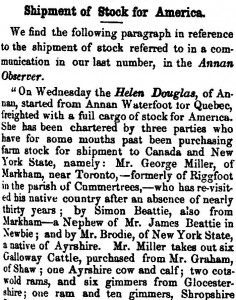Mon 4 Jul 2011
1867 Visit with the Millers
Posted by Jim under George Miller/Riggfoot, History, John Miller/Thistle Ha', William Miller SrComments Off on 1867 Visit with the Millers
In an 1867 letter to the editor of the farm journal The Canada Farmer, correspondent George Buckland reported on his visit with the Millers in Pickering and Markham townships, giving us a glimpse of the Miller enterprises 144 years ago. It is interesting that George Miller was farming a total of 1,100 acres [445 hectares] in 1867.
Source: George Buckland, correspondence to the editor, “A Few Days with the Messrs. Miller”, The Canada Farmer, Volume IV, Number 18, Globe Printing Company, Toronto, September 16, 1867, pp. 280-281.
A Few Days with the Messrs. Miller.
To the Editor of the CANADA FARMER:
Sir, I had the pleasure of a day’s intercourse with Mr. John Miller, of Pickering, who occupies a situation commanding a view of one of the finest landscapes that is to be met with in this section of Canada. Mr. Miller has some well-bred pure Durhams [English Shorthorn cattle], and an excellent bull, that is doing good service in the neighborhood. His herd of grades, consisting of cows and young stock, is really superb, illustrating the supreme importance of what I endeavour everywhere to enforce, the necessity and advantage of using a pure-bred male animal in all our endeavors to improve permanently the live stock of the country, and wherever practicable, no other. The sheep on this farm, consisting of Leicesters and Cotswolds, are very superior, denoting great care and sound judgment in their breeding and management. The high character which the Millers have long earned in this particular department of agriculture, continues to be well sustained. Mr. William Miller, father of John and brother of George, of Markham, has now retired from active business; he is among the oldest, perhaps the oldest improver of farm stock in Canada, and both he and his brother George were favorably known in Scotland in these relations, nearly half a century ago. They now own and cultivate a large tract of very productive land, in this and the adjoining township. Mr. John Miller’s four years old Clydesdale Stallion is a very pretty symmetrical animal, rather small, but having the more distinguishing characteristics well brought out; he is a sure stock getter, and his numerous progeny are well liked by the farmers.
(more…)

